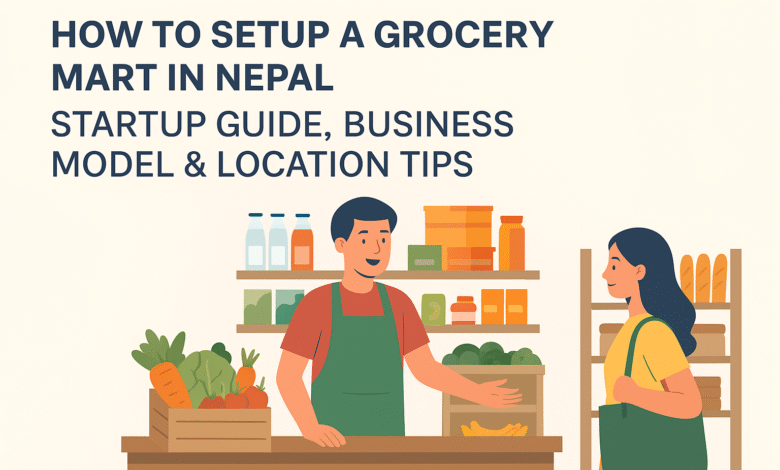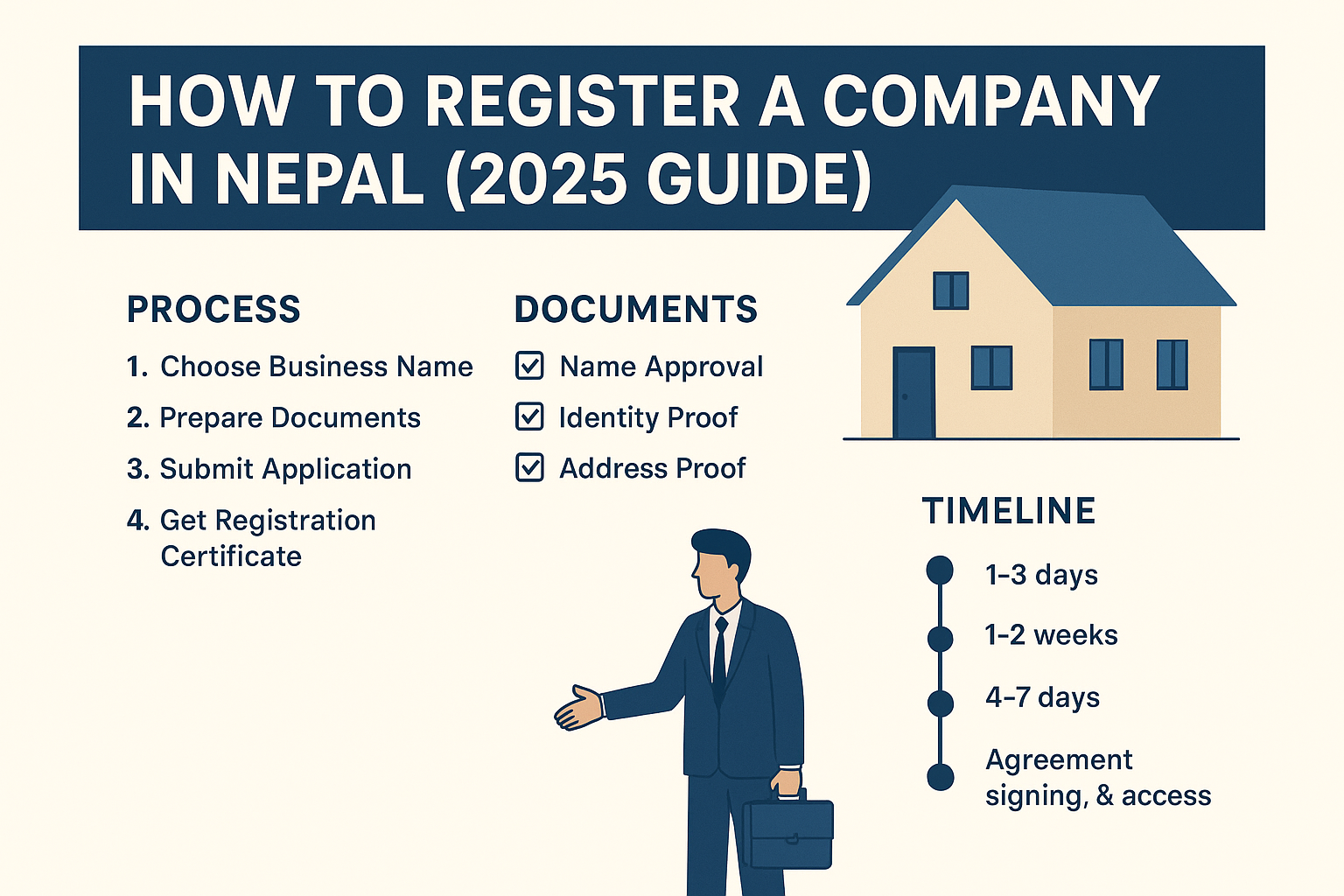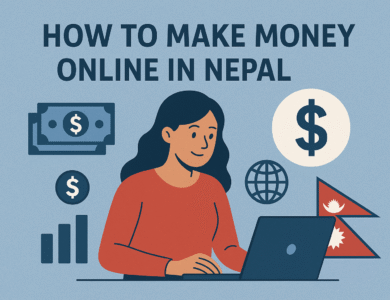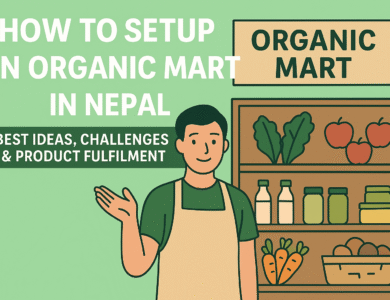How to Setup a Grocery Mart in Nepal | Startup Guide, Business Model & Location Tips (2025)

How to Setup a Grocery Mart in Nepal – Best Ideas, Challenges & Startup Guide
A grocery mart is one of the most sustainable and profitable businesses in Nepal, as food and household supplies are basic needs for every family. From small neighborhood shops to large supermarkets, the grocery business has steady demand throughout the year.
If you are planning to open your own grocery mart, this guide will help you with startup ideas, problems, product fulfillment, business models, and location selection.
Why Start a Grocery Mart in Nepal?
- Daily Demand – Groceries are essential, ensuring a continuous flow of customers.
- High Profit Margin on Some Products – Packaged goods, spices, and FMCG products have good profit margins.
- Scalability – You can start small and expand into a supermarket chain.
- Urbanization & Lifestyle Change – People prefer marts and supermarkets for convenience and variety.
- Cash Flow Business – Grocery marts provide regular income without long waiting periods.
Best Ideas for Starting a Grocery Mart in Nepal
1. Neighborhood Grocery Store
A small shop in a residential area focusing on essential items like rice, lentils, oil, vegetables, and snacks.
2. Mini Mart in Urban Centers
A mid-sized mart near colleges, offices, or apartments selling packaged food, frozen items, drinks, and personal care products.
3. Large Supermarket Model
A big investment setup with a wide range of products including groceries, clothing, electronics, and kitchenware.
4. Online Grocery Mart
An app or website-based grocery delivery service targeting busy customers in cities like Kathmandu and Pokhara.
5. Hybrid Model (Mart + Online Delivery)
Best option for modern Nepal – a physical mart combined with online ordering and home delivery.
Location Selection for Grocery Mart in Nepal
Choosing the right location is the most critical factor:
- Residential Areas – High customer base for daily groceries.
- Near Schools, Colleges & Offices – Demand for quick snacks and packed foods.
- Main Market Centers – Best for large supermarkets.
- Housing Colonies & Apartments – Growing trend in urban Nepal.
- Avoid Overcrowded Competition Zones – Balance between foot traffic and nearby competitors.
Products to Include in Grocery Mart
- Basic Staples – Rice, flour, pulses, lentils, sugar, salt, oil.
- Vegetables & Fruits – Seasonal and fresh.
- Dairy Products – Milk, ghee, butter, yogurt.
- Packaged Food – Biscuits, noodles, snacks, frozen food.
- Beverages – Tea, coffee, soft drinks, juice, mineral water.
- Personal Care & Household Items – Soap, shampoo, detergents, toothpaste.
- Spices & Condiments – Chili, turmeric, masala packets.
- Frozen & Ready-to-Cook Items – Sausages, momo, frozen vegetables.
- Eco-Friendly & Organic Products – Millet, flax seeds, honey, herbal teas.
Challenges of Grocery Mart in Nepal
1. High Competition
Many grocery stores already exist in every city.
Solution: Differentiate with discounts, loyalty programs, online delivery, or better service.
2. Supply Chain & Product Fulfillment
Unstable supply of fresh produce and wholesale goods.
Solution: Partner with multiple suppliers and local farmers for continuous supply.
3. Inventory Management
Short shelf-life of perishable goods.
Solution: Use inventory tracking software and maintain stock rotation.
4. Pricing Pressure
Customers compare prices with nearby marts.
Solution: Negotiate bulk discounts with wholesalers and offer combo deals.
5. Storage & Logistics
Lack of cold storage for dairy, meat, and vegetables.
Solution: Invest in refrigerators and ensure proper warehouse management.
Business Module for Grocery Mart in Nepal
1. Small-Scale Mart (Local Shop)
- Investment: NPR 3 – 7 Lakhs
- Area: 200–500 sq. ft.
- Products: Daily essentials only
2. Medium-Scale Mart (Mini Mart)
- Investment: NPR 10 – 20 Lakhs
- Area: 800–1500 sq. ft.
- Products: Essentials + FMCG + frozen items
3. Large-Scale Supermarket
- Investment: NPR 30 Lakhs – 1 Crore+
- Area: 2000 sq. ft. and above
- Products: Groceries + Electronics + Lifestyle items
4. Online Grocery Mart
- Investment: NPR 5 – 15 Lakhs
- Includes: Website/App, delivery system, inventory warehouse
Steps to Start a Grocery Mart in Nepal
- Market Research – Study local demand and competitors.
- Business Registration – Register with PAN/VAT.
- Location Selection – Choose high-footfall residential/market area.
- Setup Store/Online Platform – Interior setup, shelves, billing system, or app development.
- Supplier Agreement – Partner with wholesalers and distributors.
- Hire Staff – Cashier, stock manager, delivery staff (for online).
- Marketing & Promotion – Flyers, banners, social media ads, and loyalty programs.
- Digital Payments – Add eSewa, Khalti, and QR payment options.
Marketing Ideas for Grocery Mart in Nepal
- Discount Days – Weekly offers to attract repeat customers.
- Membership Card System – Reward loyal customers.
- Online Delivery & Subscription Model – Daily milk/vegetable delivery.
- Social Media Promotions – Target local audience via Facebook and TikTok ads.
- Partnerships – Tie-up with offices and apartments for bulk supplies.
Final Thoughts
Starting a grocery mart in Nepal is one of the safest and most profitable business ideas, as food is a necessity for every household. The key to success lies in choosing the right location, managing product fulfillment, and adapting modern business modules like online delivery and loyalty programs.
With proper planning, customer-focused service, and efficient supply chain management, you can build a grocery mart that not only generates steady profits but also grows into a trusted supermarket brand in Nepal.
👉 The demand is rising, and the best time to start your grocery mart is NOW.




